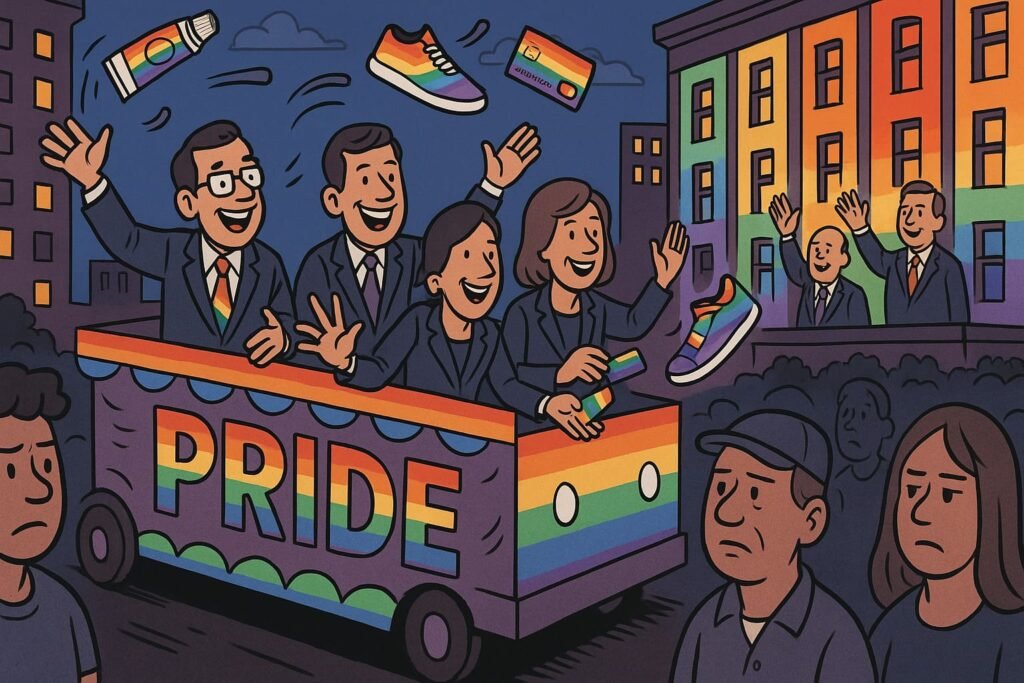Pride Explained – From Rights to Rainbow Capitalism
Once upon a time, Pride meant not being jailed for who you loved. It was about dignity, not branding. Fast forward: Pride now comes with corporate floats, rainbow bank cards, and HR seminars. What began as a demand for rights has turned into a month-long marketing campaign — where selling socks is activism and not clapping hard enough is heresy.
Table of contents
Pride Then vs. Now
The first Pride marches were about survival. “We exist. Stop harassing us.” Simple, human, and necessary.
Now? You can’t buy toothpaste without a rainbow on the box. Pride stopped being a shield against discrimination and became a sword waved in every boardroom, classroom, and government department.
From Rights to Rainbow Branding
Every June, corporations compete in the Pride Olympics: rainbow vodka, rainbow sneakers, rainbow fries. Not solidarity — sales. Nothing breeds brand loyalty like convincing customers that shopping is a moral act. “Swipe your rainbow Mastercard, save the world.”
The Business of Identity
Corporations figured it out: selling identity is more profitable than selling products. If buying socks makes you feel virtuous, you’ll buy twice as many. Activists get visibility, CEOs get applause, shareholders get profits. Everyone wins — except ordinary people who see through the theatre.
The Problem with Infinite Labels
LGBT became LGBTQ, then LGBTQIA+, and counting. Activists proudly declare the alphabet never ends. Why? Because every new identity creates new leverage — in politics, media, HR hiring, and corporate sponsorships. Identity has become a currency, and like all currencies, inflation makes it meaningless.
Pride as Political Weapon
Politicians love Pride. Light up a building in rainbow colours, ignore the housing crisis. Parade down the street, keep silent on failing schools. Cheap symbolism pays — and anyone sceptical risks being labelled a “bigot.” Debate isn’t allowed; compliance is demanded.
Corporate Hypocrisy in Action
Big brands drape themselves in rainbows in New York but stay silent in Riyadh, where homosexuality can mean prison. The hypocrisy is staggering: morality only where it sells. If Pride were truly about rights, these corporations would stand firm everywhere. Instead, they slap a rainbow on shampoo bottles and call it activism.
Who Really Benefits?
- Corporations get new customers and virtue points.
- Activists get endless relevance and funding.
- Politicians get applause without fixing anything.
- And the rest? Ordinary people who wanted tolerance now feel force-fed ideology.
What We Lost Along the Way
The moral high ground. Pride once said, “Leave us alone.” Now it says, “Clap louder.” What was a fight for dignity has become a parade of conformity — alienating those who once supported it.
The Pride Bubble Will Pop
The golden rule of movements: once you win, you risk becoming the establishment. Pride no longer challenges power — it is power. And like every fad that grows too big, too loud, and too self-righteous, it will eventually collapse under its own weight.
Until then, expect another rainbow coffee cup. Not because they care — but because it sells.
FAQ
What was the original purpose of Pride?
To demand dignity and equal rights for gay and lesbian people — not corporate branding.
Why has Pride become controversial?
Because it shifted from tolerance to enforced ideology, mixed with corporate opportunism.
Who benefits most from modern Pride?
Corporations, politicians, and activists — often at the expense of ordinary people.
Is Pride still about rights today?
In some places, yes. But in the West, it’s more about branding, politics, and conformity than basic freedoms.



